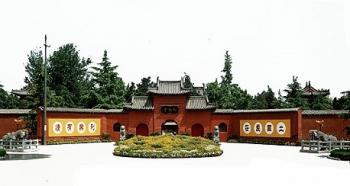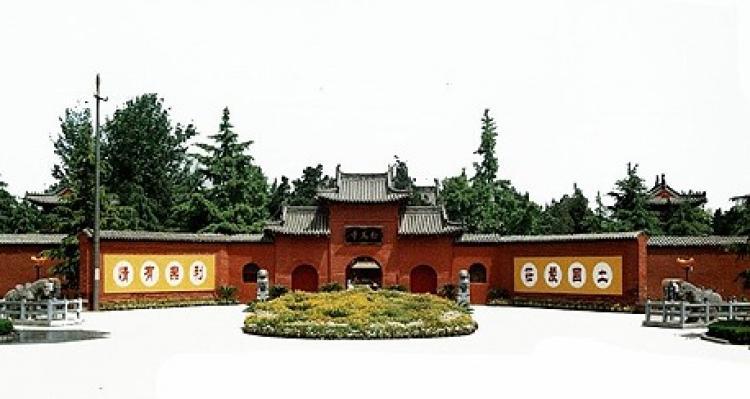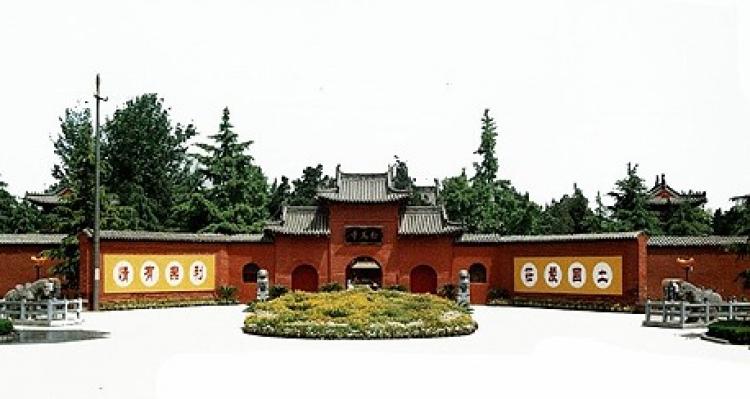The White Horse Temple, the oldest temple in China, is located about 6 miles from the city of Luoyang in eastern China’s Henan Province. It is a place that disciples of the buddha school recognize as the palace of buddhist ancestors and the place where buddhist theory was taught.
it was built by Emperor Ming of the Eastern Han Dynasty (29 A.D.–75 A.D.), and there is a legend about its establishment.
According to the historical book of records, Emperor Ming dreamed of a pleasant scene in which a shining golden god flew into his palace. Emperor Ming called his ministers to inquire about his dream. Minister Fuyi said: “On April 8 of the 24th year of King Zhou in the Zhou Dynasty (971 B.C.), the landscapes rocked and the rivers flooded. At night the splendid light beams of five colors flashed in the western sky.”
The official historian Su estimated that it was a sign of a great saint’s birth in the Western Paradise. “The saint came to earth to rescue people from their suffering and miseries. His moral principles would be introduced into our country 1,000 years later. Now, 1,000 years have passed, and it is about time. I have heard that there is a western saint respectfully called “Buddha,” so it may be the “Buddha” Your Majesty has dreamed of.”
In order to understand the Buddha, Emperor Ming sent 12 delegates to the Western Regions to look for Buddha and explore Buddhism.
The 12 people overcame tremendous difficulties and dangers and finally arrived in Tai Yueshi country located in the Western Regions where Buddhism had been widely spread and numerous temples existed. The team then collected a number of Buddhist scriptures as well as statues and invited the Tianzhu senior monks ,She Moteng and Zhu Falan from India to preach Buddhism in the central plains (central China). In Emperor Ming Yongping’s tenth year (67 A.D.), they returned to Luoyang, the capital of the Eastern Han Dynasty.
Emperor Ming was very pleased and formally summoned the two senior monks. He cordially invited them to stay in Honglu Si, an Institute under the Diplomacy Office, and sincerely requested that they translate the Buddhist scriptures they brought back.
The next year, Emperor Ming issued an edict to build a monastery outside Yung Gate of Luoyang. “Si” originally meant a government office. However, since monks She Moteng and Zhu Falan first came to stay at “Si,” and as they were also foreign guests, their new home was still called “Si” as a gesture of courtesy. Since then, the Chinese Buddhist temple has been called “Si” in Chinese. In addition, as it was a white horse that had carried all of the Buddhist scriptures and statutes, to commemorate the contribution of that white horse, the new monastery was named White Horse Si, or, the White Horse Temple.
The two senior monks She Moteng and Zhu Falan, preached at White Horse Temple and jointly completed the translation of the 42-Chapter Sutra, the first Chinese version of Buddhist scriptures. After She Moteng passed away, Zhu Falan continued to translate a number of scriptures. Their translations of the scriptures were all treasured in the Main Hall for the monks to worship. It was said that in the Northern Wei Dynasty (386 A.D.– 534 A.D.), when the Buddhist monks worshiped the scriptures, the scripture suddenly glowed with five-colored luminous lights and lit up the Main Hall brightly. It was even more amazing that the image of a Buddha was visible within the light beams.
During the reign of Tang Dynasty Empress Wu Ze Tian (624 A.D.–705 A.D.), the White Horse Temple was very popular, and there were more than 1,000 monks living there. However, the Temple was greatly damaged during the An Si Rebellion (755 A.D.–763 A.D.) and the Huichang Suppression of Buddhism (840 A.D.–846 A.D.). The damaged White Horse Temple was only found later through broken pieces of inscriptions on the stones and ruins. Repairs to the temple were later conducted by Sung Dynasty Emperor Taizong (939–997), Ming Dynasty Emperor Jiajing (1507–1567), and Qing Dynasty Emperor Kangxi (1662–1722).
The existing White Horse Temple occupies 47,840 square yards and contains more than 100 temples lining up vertically. The major halls located in a central line from south to the north and from the gate into the mountain are as follows: the Hall of Heavenly Kings, the Hall of the Great Buddha, the Hall of Mahavira, the Hall of Guidance, and the Buddha Pilu Court.
In the center of the Main Hall of the Great Buddha, there is a large statue of Sakyamuni Buddha flanked by two of his disciples, Jiaye and Ananda, and figures of Manjusri and Samantabhadra.
In the southeast corner of the Hall, there hangs a Ming Dynasty cast iron bell weighing 5,525 pounds. It was said that during breezy nights or fresh dawns, the sounds of that bell could be heard dozens of miles away, and the big bell which hung in the city’s East Avenue clock tower could resonate with it; thus the scene could be described as “the bell resounds up to the Buddha’s Palace and down to astound the ghosts of hell.”
After the Hall of the Great Buddha is the Hall of Mahavira, where Sakyamuni, Amitabha, and Medicine Buddha are surrounded by 18 Arhats with different poses and expressions. The statues are very precious since they were built with exquisite craftsmanship using silk and hemp in the Yuan Dynasty (1271–1368).
After the Hall of Mahavira is the Hall of Guidance and finally the Buddha Pilu Court. Pilu Court was built in the Tang Dynasty (618 A.D.–907 A.D.), which worships Buddha Pilu, the Pure Dharma Body of Buddha Sakyamuni, with Bodhisattvas Manjusri and Samantabhadra standing at two sides. The monument behind the Court was engraved with the 42-Chapter Sutra.
In the southeast and southwest corners of White Horse Temple, are the graves of She Moteng and Zhu Falan. About 220 yards southeast of the Temple, there is a tower 26 yards high with 13 layers of brick, called Qi Yun Tower. The original name of the tower is Jiashelita Tower, Golden Square Tower, or the White Horse Temple Tower. It was built in the Tang Dynasty, destroyed in the Song Dynasty (960 A.D.–1279 A.D.) and restored in the Qin Dynasty (1115–1234).
The most popular tourist attractions of White Horse Temple are as follows: Clear and Cool Terrace, Midnight Bell, QI Yun Tower, Vine Orchid Tomb, Broken Script Monument, and the Sutra Burning Platform.
Read original Chinese article



Friends Read Free